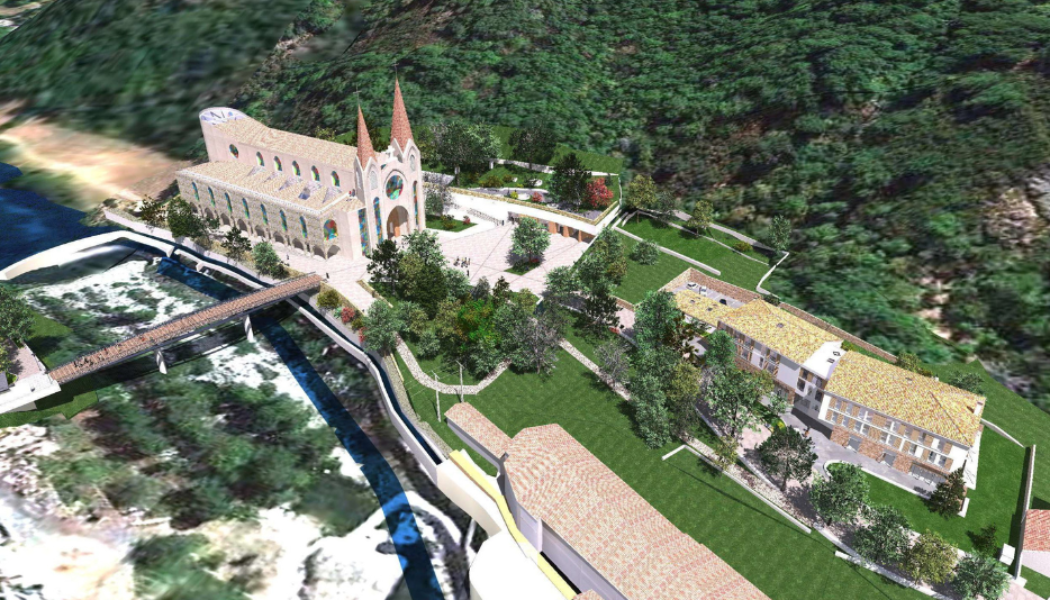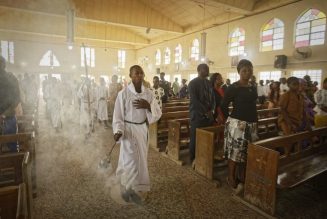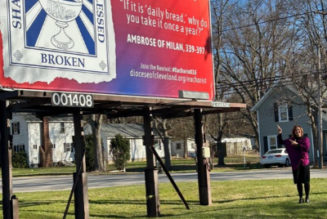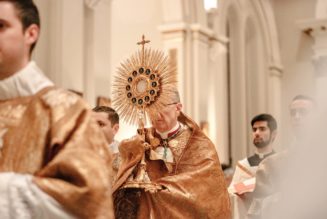The startling scene of a nun chasing and tackling an environmental activist Oct. 17 continues to make the rounds on social networks.
The matter that led to this spectacular confrontation, however, is not recent, and has its origins in a controversial sanctuary construction project initiated in 2018 within the Diocese of Viviers, in the Monts d’Ardèche regional park in southeastern France.
It has to be said that the project led by the Missionary Family of Notre-Dame (FMND), founded in 1946 in the aftermath of World War II, is particularly ambitious given the current state of the Church landscape in France, whose trend has been of steady decline for years, while historic Catholic monuments are disappearing one after the other. Since the start of construction in 2019, the site has been the target of environmental activists, who have denounced the risk to biodiversity in the valley bordering the Bourges River.
These accusations are unfounded, according to the community’s superior, who indicated in an interview with the Register that the public authorities, backed by prior environmental studies, support the project. He also claims that the diocese’s bishop was initially an enthusiastic supporter of the project, before changing his position once work began.
A Vast Chapel for an Expanding Pilgrimage
The construction of a sanctuary to welcome the faithful during the traditional Our Lady of the Snows pilgrimage, which takes place in the village of Saint-Pierre-de-Colombier every December, has been an ambition of the FMND since its foundation.
The community — which today numbers some 160 members spread over 18 houses — was born in the wake of the inauguration of a statue of Our Lady of the Snows in the aftermath of the Second World War. In June 1944, parishioners of Saint-Pierre-de-Colombier vowed to have a statue erected in her honor if the village was spared the German debacle — a prayer that was largely answered, as the enemy army never came close to it and the prisoners of war all returned safely. The statue, blessed by the local bishop on Dec. 15, 1946, has since been the object of veneration by many faithful, who go there on pilgrimage every year on the same date.

After the 2000s, when the community (recognized as a congregation of diocesan right in 2005) experienced a sudden boom after initial decades poor in vocations, the number of faithful and visitors also grew exponentially, attracting some 2,000 people to the annual pilgrimage from 2014 onward. With the parish church unable to accommodate the influx of pilgrims, the community initially had to hold two separate celebrations every December.
This rekindled the wish of their founders, Father Lucie-Marie Dorne and Mother Marie Augusta, to build a sanctuary where as many people as possible could come to venerate and pray to Our Lady of the Snows.
The construction project, approved by the regional authorities in 2018, includes a vast church with a capacity of 3,500 people, along with annex buildings, a church square, a guest house with a garage, a parking lot for pilgrim coaches and a walkway over the Bourges River.
This large-scale project, estimated at just under 18 million euros, is to be funded exclusively by private donations, as the Missionary Family states on its website.
Growing Tensions with Environmental Activists
The work begun in 2019 quickly aroused hostility in the region, the main argument raised by its opponents being ecological in nature, with some fearing the impact of “concreting” on the environment of the Bourges valley, aggravated by the massive influx of visitors to the site. Others made no secret of their anti-clerical motives — as evidenced by the various banners brandished during a demonstration in 2019 — toward a community often labeled as “traditionalist” in the national press. Indeed, the FMND regularly celebrates Mass in Latin, but in the Ordinary Form. It was therefore not one of the many communities in France affected by the restrictions of the motu proprio Traditionis custodes.
The support of the Ardèche department’s prefect and the environmental studies in favor of the project did not weaken the determination of the opponents who, gathered in an association (Pour l’Avenir de la Vallée de la Bourges – “For the Future of the Bourges Valley”), caused the work to be suspended between 2020 and 2022 and filed a petition for suspension in 2023 when the prefect ordered the resumption of work. The failure of their appeal raised the tension a notch in early October, when activists decided to invade the site to forcibly block further construction of the site’s guest house.
After initial disturbances on the site’s outskirts Oct. 12, activists broke into the construction site Oct 16 and 17, forcing their way through the surrounding fences, despite the presence of gendarmes. This time, the opponents were faced with a number of religious members of the community and local supporters, determined to guarantee the continuation of the work, after several unsuccessful attempts at dialogue. Among them was Sister Benoîte, whose tackle of an activist in a scene resembling a rugby match was immortalized by TV cameras and broadcast on social networks, accumulating several million views in just a few hours.
“We stepped in to stop them harming the workers and chaining themselves to the fence,” sister Benoîte commented in an interview with the Register. “When a brother told us they were using PVC tubes to chain themselves, seeing an opponent carrying four of them, I tried to catch up with him with the sole aim of recovering those tubes,” she added, specifying that she and other community members and supporters formed a peaceful cordon around the protesters and then around the digger to protect it for the rest of the day.
“We prayed the Rosary continuously throughout the day, which strengthened our unity in calm, and we are of course praying for the Our Lady of the Snows site and for the opponents.”
Support from Regional Authorities, Opposition from the Diocese
The scuffles, which left three people slightly injured, including a friar who was taken to a hospital with a sprained ankle, were condemned by the Prefect of Ardèche, Sophie Elizeon. In a statement dated Oct. 18, she spoke out against “the actions of people who broke the law, engaged in violence and caused damage to property.”
“The law must and will prevail,” she wrote, pointing out that for the time being, “nothing stands in the way of continuing the work” and that the new legal action by the Association pour l’Avenir de la Vallée de la Bourges has no suspensive effect.
While the support of the local prefectural authorities has remained unchanged since 2018, relations between the congregation and the local church hierarchy have deteriorated over the years. Bishop Jean-Louis Balsa, head of the Viviers diocese between 2015 and August 2023, officially prohibited construction of the chapel (he has no authority over the outbuildings) with a decree in September 2020. In a statement issued in March 2021, he justified his decision by saying that the community had not complied with his request to conceive a building “more modest in size and cost,” and that the project as it stood appeared to him to be “disproportionate.”
For his part, the superior of the Missionary Family, Father Bernard Domini, claims that this request from the bishop came 14 months after work began, and that he had initially approved the project as it stood, encouraging them to continue moving it forward.
“After expressing his enthusiasm when he took office, he repeated in front of 70 members of our community in 2016 that our church project was in line with our vocation, which is not to run parishes but to develop a spiritual center,” he told the Register, pointing out that Bishop Balsa had simply asked them to have the guest accommodation erected first, then the church afterward.
“When we received the building permit, we informed the bishop and by virtue of French law, we displayed the license in front of the construction site for several months, which should allow any opponents to file appeals,” he continued, adding that throughout this legal period, neither the diocesan authorities nor environmentalist opponents came forward.
“It took us three years of work to get the building permit, and to comply with the bishop’s new request, we would have had to start the whole procedure again from the beginning, which would have meant destroying the whole project, since this time the associations would have been able to lodge their appeals within the legal deadlines and have it canceled.”
The Register contacted Bishop Balsa – who left the Diocese of Viviers last August – about the allegations, but he had not responded by the time the article was published.
Having reached an impasse, in 2021 the community submitted an appeal to the Vatican’s Dicastery for Institutes of Consecrated Life and Societies of Apostolic Life through an ecclesiastical lawyer. Shortly afterward, however, the dicastery confirmed Bishop Balsa’s decree of prohibition.
Apostolic Visitation
“The decision was taken by Archbishop José Rodríguez Carballo [Secretary of the Dicastery] in consultation with our bishop, without our lawyer or any of us being contacted and asked any questions,” the superior lamented.
Rome’s decision came in the wake of a canonical visitation initiated in 2019, which had highlighted difficulties regarding the exercise of authority and obedience within the community. After calling on the congregation to deepen the document on the Service of Authority and Obedience published by the dicastery in 2008, Archbishop Rodríguez commissioned an apostolic assistant, Bishop Jean-Christophe Lagleize, who accompanied the community throughout 2022 to help them prepare their general chapter held in January 2023. The Bishop Emeritus of Metz had told the daily La Croix the same year that he felt the missionary family needed an adjustment in its governance due to its sudden and significant growth in the past two decades.
“We welcomed all the remarks made to us at the end of these visits, some of which were also very positive, with confidence and obedience,” said Father Bernard, adding that it was in this same spirit of obedience that the community would observe the decree prohibiting the construction of the sanctuary chapel.
He said that work on the surrounding buildings would continue as planned, pending the appointment of a new bishop to head the diocese. “We hope that the next bishop of Viviers will help us find a suitable solution for the future of our spiritual center, and in the meantime, we are ready to set up a marquee for major religious celebrations,” he concluded. “We have lived in total abandonment to divine Providence since our foundation, and this is what we will continue to do.”








